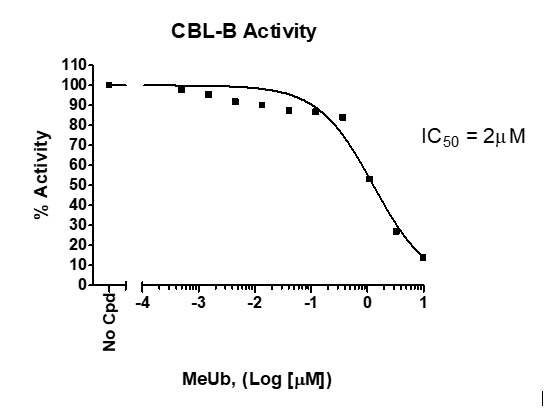CBL-B Assay Service
●
Target
CBL-B
●
Description
Screening and/or profiling inhibitor compounds against CBL-B E3 ubiquitin ligase activity in a biochemical assay.
●
Synonyms
UBE1, UBA1, ubcH5b, UBE2D2, E3 ubiquitin-protein ligase CBL-B, RING finger protein 56, CBL, CBLB
●
Example Data

*Example only, final data may vary.
Assay Details
●
Assay Format
TR-FRET
●
Reference Compounds and IC50
Methylated Ubiquitin, 5 μM
●
Assay Principle
The CBL-B TR-FRET Assay is designed to measure CBL-B auto-ubiquitination activity in a homogeneous 384 reaction format. It utilizes biotin-labeled Ubiquitin and a terbium-labeled antibody recognizing the GST-tagged CBL-B protein to complete the TR-FRET pairing. This FRET-based assay requires no time-consuming washing steps, making it especially suitable for high throughput screening applications.
Target Details
●
Protein Family
Ubiquitination
●
UniProt
CBL-B: Q13191
●
Background
CBL-B, a RING finger E3-ubiquitin ligase, acts as an intracellular checkpoint and a regulator of cytotoxic lymphocytes and NK cells. CBL-B binds E2-ubiqutin as well as target proteins such as TAM receptor TYRO3, forcing further degradation of TYRO3. CBL-B modulates innate immune responses and plays a key role in host defense to pathogens and anti-tumor immunity. Targeting CBL-B represents a potential therapeutic strategy for the management of human immune-related disorders such as autoimmune diseases, infections, tumors, and allergic airway inflammation. CBL-B has emerged as a new target of interest in the field of immunotherapy due to its ability to suppress cancer immune-evasion. CBL-B initiates anti-cancer immune responses in NK cells in both cytotoxic and effector T cells, promoting T-cell and NK cell activation.
Delivery
●
Estimated Turnaround
Two to three weeks following delivery of compounds
●
Results
Extensive report with raw and analyzed data, graphs, and detailed protocols. Includes positive control for inhibition.

